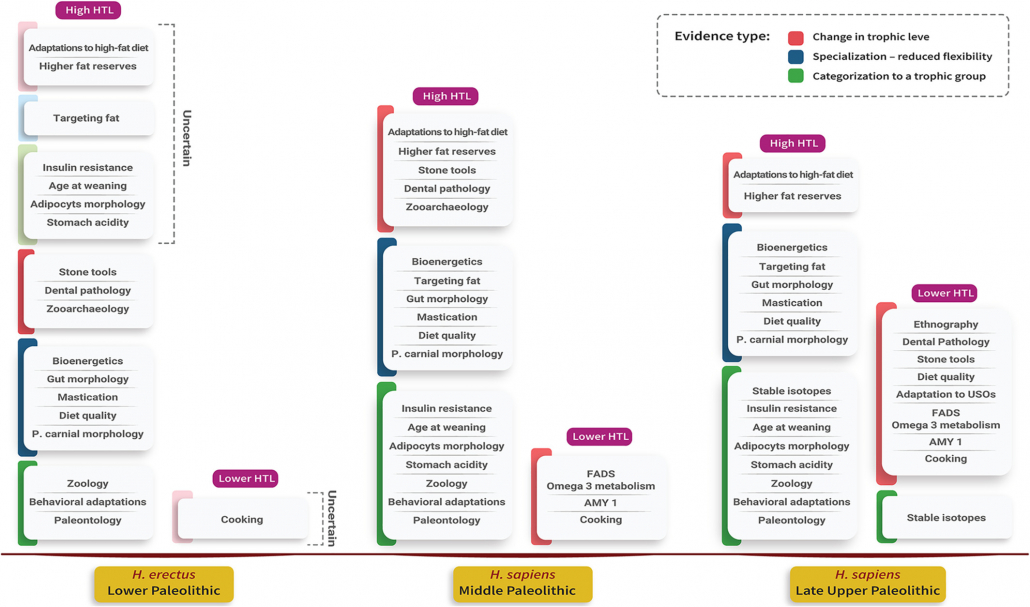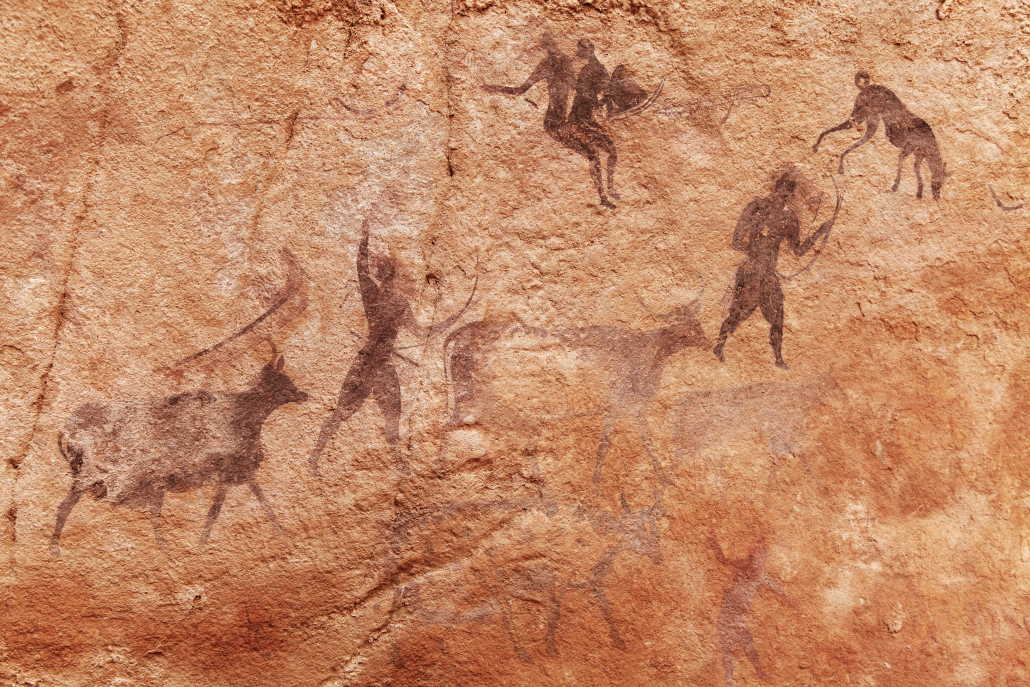We include products in articles we think are useful for our readers. If you buy products or services through links on our website, we may earn a small commission.
What Did Cavemen Eat? Lots of Meat, New Study Reveals
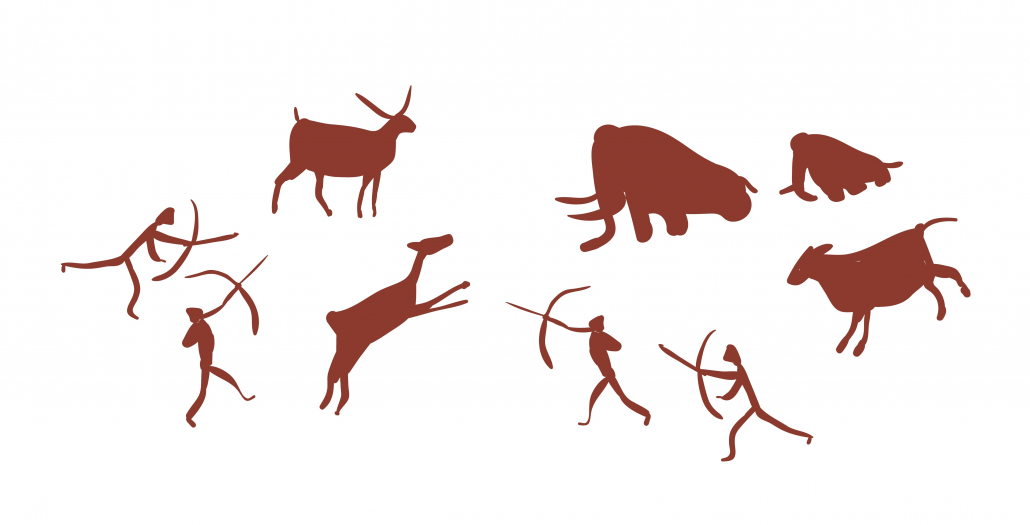
Table of Contents
Popular diet trends like paleo, ancestral, ketogenic, and carnivore diets are all inspired by different ideas about human dietary evolution. In other words, these diets each bill themselves as the answer to the question, what did cavemen eat?
A comprehensive new paper by researchers at Tel Aviv University published in the Yearbook of Physical Anthropology, brings together over 400 studies revealing a picture of our ancestors spending 2 million years as hyper-carnivorous “apex predators.” This means that for the vast majority of human history humans evolved by hunting and eating mostly large animals.
Hyper Carnivorous Ancestral Diet
This picture of a hyper-carnivorous ancestral diet proposed by Prof. Ran Barkai and other researchers is unprecedented in its inclusiveness and breadth, making for a bellwether moment in the conversation about what our cavemen ancestors actually ate.
Fellow researcher Miki Ben-Dor explained, “So far, attempts to reconstruct the diet of stone-age humans were mostly based on comparisons to 20th-century hunter-gatherer societies. This comparison is futile, however, because two million years ago hunter-gatherer societies could hunt and consume elephants and other large animals – while today’s hunter-gatherers do not have access to such bounty.”
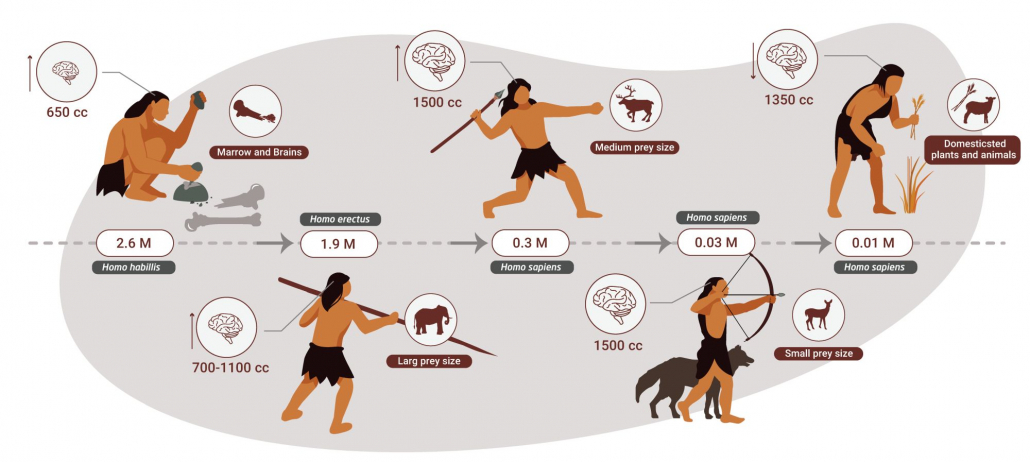
Source Miki Ben-Dor
Humans Were Apex Predators for Nearly 2 Million Years
The argument of Ben-Dor and colleagues turns on the idea of the trophic level–or the position our human ancestors inhabited on the food chain. For decades there has been a debate about whether ancient humans were general omnivores that hunted and gathered food from various trophic levels, including small prey, tubers, fruits, and some vegetables. Or were we specialized apex predators that focused almost exclusively on hunting and eating large animals?
Though the ability to gather food from many sources might sound compelling–the dietary equivalent of a diversified investment portfolio–as apex predators in a world running wild with nutrient-dense mastodons and 2000 lb chinchillas, why would we choose to spend energy gathering and eating far less nutritious foods?
This new study argues that we wouldn’t.
What Did Cavemen Eat? 17 Scientific Insights
Here’s a summary of key insights from the study aimed at answering the controversial question: what did cavemen eat?
1. Bioenergetics
Humans needed a lot of energy relative to our body mass and had a short time of day to get it. We had a 10X return on energy spent hunting compared to acquiring plants. Animals almost always specialize in the highest return on calories.
Interestingly, that’s why we’re addicted to cheap processed foods–they’re loaded with calories and almost effortless to acquire.
2. Diet quality
When we look at primates, the larger the brain, the more energy-dense the food they eat. Humans have the largest brain of all primates, and so it’s likely that we targeted the highest density food in our trophic level–animals loaded with fat and proteins.
We also see that during the end of the Pleistocene era, brain size declined alongside the decline in megafauna. At the same time, isotope evidence shows that this is when humans began eating more plants.
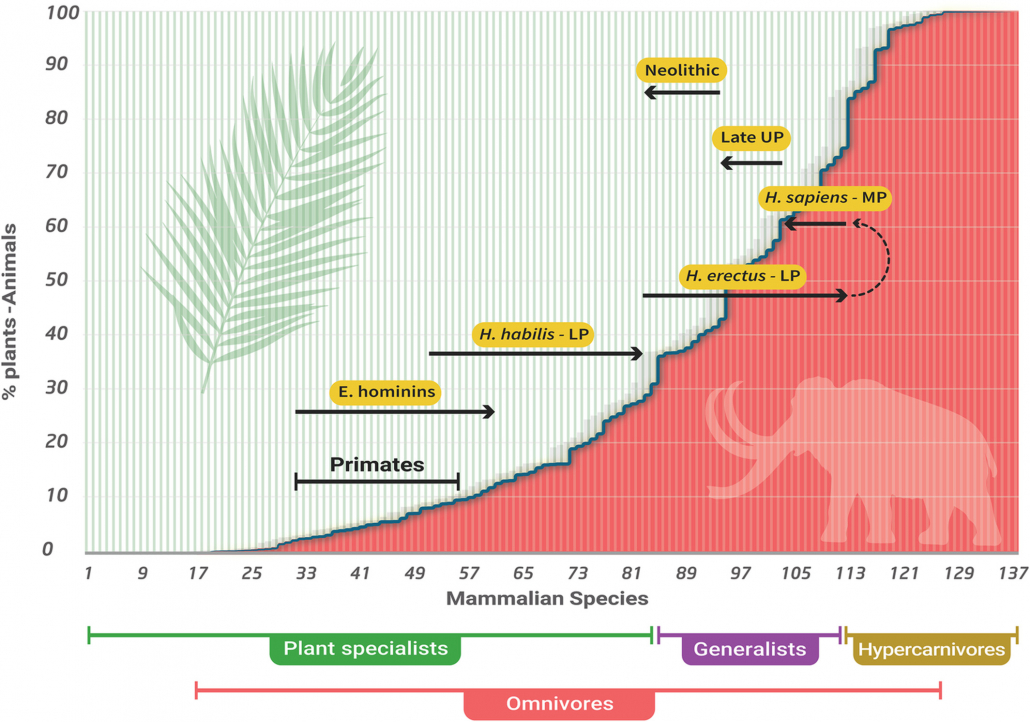
3. Higher Fat Reserves
Humans have much higher body fat reserves than other primates. And we can go into ketosis–the metabolic state where our bodies use fat rather than carbohydrates for fuel–more quickly than fellow facultative carnivores like wolves.
This makes us unique in our ability to endure extended periods of fasting. Researchers believe we adapted these traits to overcome periods of fasting when we couldn’t find large prey to hunt. This supports the idea that we were apex predators at the highest trophic level.
4. Genetic and Metabolic Adaptations to High Fat Diet
Compared with other primates we see that humans are genetically adapted to higher fat diets. The highest fat sources were certainly animal meats.
Whereas chimpanzees have open regions of their genetic code to metabolize a high sugar diet, humans have closed parts of the genome to accommodate eating a high-fat diet. The authors theorize that it makes sense that we would be adapted to high fat when eating a carnivorous diet because we are limited in the amount of protein we can metabolize for energy.
The study also points out that the human body prioritizes the storage of fat on our body for use as fuel–another sign of our adaptation to high-fat consumption.
5. Late Adaptation to Tubers and Plant Foods
When looking at recent groups of people that eat lots of tubers, we find specific genetic adaptations to deal with plant toxins and antinutrients. But we don’t see these adaptations in other groups of people. This suggests that in some groups there has been a gradual shift from apex to lower trophic levels.
6. Stomach Acidity
Carnivores through the animal kingdom have high stomach acidity in order to protect against meat‐borne pathogens. The stomach acidity of humans’ is even higher than that of normal carnivores. In fact, it’s equal to the acidity of scavengers. Researchers suggest that this adaptation may have evolved to allow humans to eat large animals over a period of days and weeks even as pathogens accumulated in the meat.
7. Insulin Resistance
Like other carnivores, humans have low insulin sensitivity. This adaptation allows the body to prioritize glucose for the few issues that are entirely or significantly dependent on glucose like the testes, central nervous system, and red blood cells while using fatty acids and ketosis to fuel muscles. This portioning of energy suggests a reliance on fatty animal meats among humans.
8. Isotopes and Trace Elements
A compilation of 242 individuals from 49 sites shows that European hunter gatherer groups primarily pursued a carnivorous diet throughout the late stone age
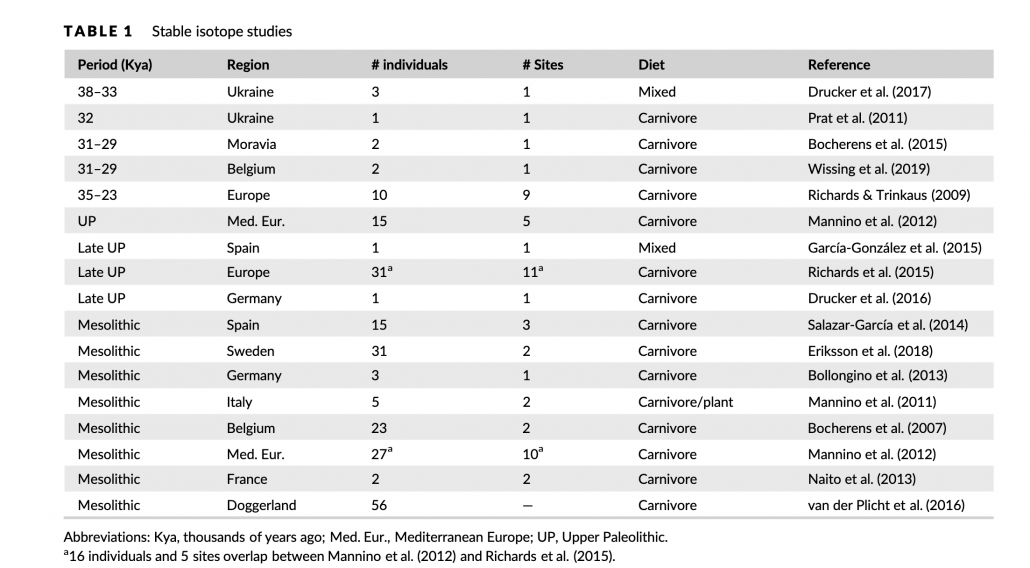
9. Gut Morphology
The shape and size of human guts relative to chimpanzees and other apes are radically different. Humans have longer small intestines and shorter large intestines consistent with the guts of other carnivores. This limits our ability to ferment and get energy from plant fibers. The authors cite this finding as supporting the view that humans were/are omnivores specialized in eating meat, otherwise known as facultative carnivores.
10. Mastication
When comparing the size of the masticatory system in Homo erectus to early hominins (pre-human species) that ate mostly plant foods, we see a reduction in size. The jaw size and shape of humans is more compatible with eating meat and dairy. These findings point to an early shift in trophic levels from plant-eating omnivore to carnivorous apex predator.
11. Skeletal Structure
When comparing early humans to our hominid ancestors we see adaptations for endurance running and shoulder bones adapted to spear throwing. Both signify key changes towards hunting. At the same time, we also see skeletal adaptations that limit the ability to climb trees. This suggests that we came down from the trees to eat the grass eaters, not to eat the grass.
Also, when looking at the fossil record you can see that the increase and decline of human body size tracks with the abundance and decline of large prey.
12. Adipocyte Morphology
Adipocytes are cells specializing in the storage of fat. The human adipocyte system is similar to those in carnivores. These findings “suggest that the energy metabolism of humans is adapted to a diet in which lipids and proteins rather than carbohydrates, make a major contribution to the energy supply.”
13. Age at Weaning
Humans, like carnivores, wean at a younger age than omnivores and herbivores. According to the study, early weaning “highlights the emergence of carnivory as a process fundamentally determining human evolution.”
14. Longevity
Due to a long childhood for humans, a large part of early human groups dependent on experienced hunters to provide meat and train the youngsters. The hypothesis follows that we evolved longer lives to maximize the proficiency of hunting that peaks at age 40. Though women are often considered to have been gatherers, early human women could have assisted in the hunt by herding large animals towards awaiting men.
What did cavemen eat? Large animals that they spent most of their long lives learning how to hunt.
15. Higher Fat Reserves
Because large prey, even during the stone age, was less abundant than small prey, humans may have evolved fat reserves to support extended fasting for days and even weeks between successful encounters and hunts.
Eating large fatty animals in combination with having to endure fasting periods selected for the body’s ability to easily use stored fat and fat from food for fuel. This is especially true for the brain, which is the most important tool that ancient humans had for hunting much stronger and larger prey.
16. Paleontology
A decline in the highest trophic level of large prey carnivores that took place 1.5 million years ago can be interpreted as a result of humans entering the top of the food chain and out-carnivoring our competitors. Some researchers view humans as responsible for the extinction of large prey throughout the Pleistocene, supporting the view that humans focused on hunting and eating megafauna. Also, humans, like other large social carnivores hunt large prey.
What did Cavemen eat? The same large fauna as other apex predators. And we were so good at it, in fact, that we kicked our competitors out of our trophic level, and may have eaten our prey into extinction.
17. Ethnography
Upper Paleolithic (later stone age) technologies are seen as an adaptation to hunting smaller prey. This means that humans were previously less adapted to hunting smaller prey.
The advent of tools for processing plant foods also took place much later, suggesting that plant foods are a relatively recent addition to the human diet.
What Did Cavemen Eat? The Takeaway
This massive study citing 25 lines of evidence from over 400 papers paints a comprehensive picture of our human ancestors as carnivore apex predators, who for around two million years focused on hunting and eating large prey.
It wasn’t until the end of extinction of larger animals (megafauna) in many parts of the globe, along with a general decline of animal food sources toward the end of the stone age, that humans gradually increased the plant foods in their diets.
Only 8500 years ago humans finally had to domesticate both plants and animals, settle down, and become farmers.
You can take a deeper dive into this complex study here
